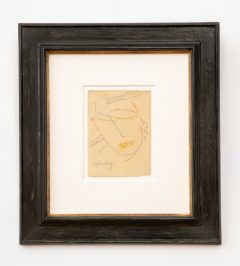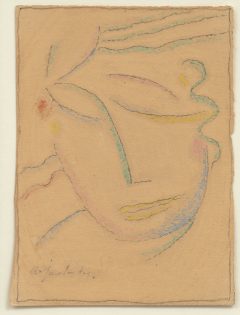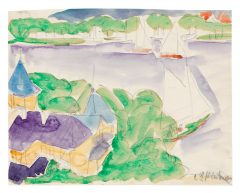Alexej von Jawlensky
Ohne Titel (Weiblicher geneigter Kopf mit geschlossenen Augen)
ca. 1922

Pastel and Pencil on handmade paper
15.5 × 11.4 cm / 6 1/8 × 4 1/2 in
Signed
Registered in the catalogue raisonné of watercolours and drawings currently in preparation
Expert opinion by Alexej von Jawlensky Archive S.A., Muralto 2021
Private Collection Southern Germany
- Galerie Ludorff, "Neuerwerbungen Herbst 2023", Düsseldorf 2023
- Galerie Ludorff, "Neuerwerbungen Herbst 2023", Düsseldorf 2023, S. 42
Alexej von Jawlensky had been particularly interested in human portraiture since 1905. After his war-related emigration to Switzerland, where he settled in Saint-Prex on Lake Geneva in 1914, he experienced a caesura not only on a personal but also on an artistic level. The series of ‘Variations on a Landscape Theme’, which he produced from 1914 to 1917, mostly on identical-format canvases, would lay the foundation for a process of steadily abstracting figurative representation and composition that would last until his death in 1941.
From 1918 onwards, with the completion of his first constructive head, the so-called ‘Urform’, the individual note disappeared in favour of a stylised, supra-individual portrait. The structure of these abstract heads was governed by a division of the physiognomic features of the human face into a basic formal language of lines, rectangles and circles, to which the later portrait series of his main work, such as the ‘Mystical Heads’, ‘Faces of the Saviour’ and finally the ‘Meditations’ of his late work, which appear sublime due to their purist style, were also lawfully prescribed.
Our work ‘Ohne Titel (Weiblicher geneigter Kopf mit geschlossenen Augen)’, a delicate, small-format pastel from around 1922, picks up on the spirit of Jawlensky's typical ‘Saviour's Faces’ with its few, yet precisely chosen strokes. They allow an ear, flowing strands of hair, lips and devoutly gazing eyes to literally take shape out of nothing. Subtle colour accents of sunny yellow, pale pink and turquoise lend the work the ephemeral aura of a supernatural apparition and illustrate the artist's ability to manifest the divine in the expression of the portrait.






